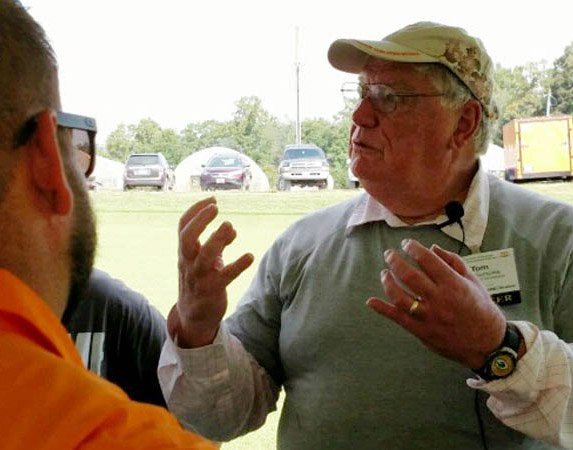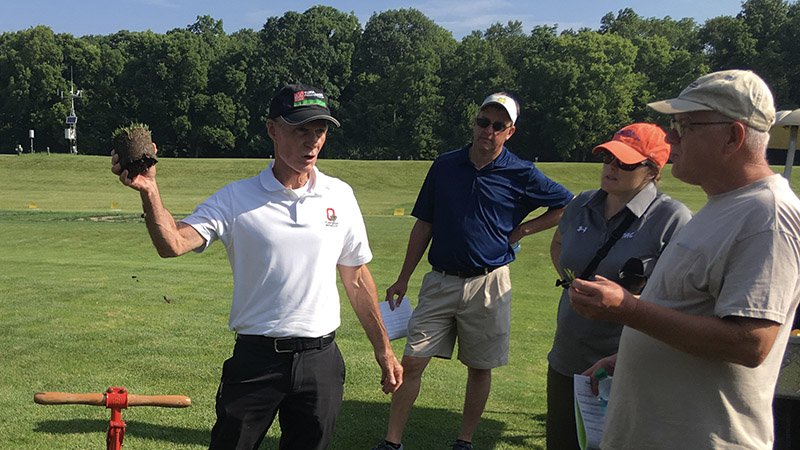By now, Tom Samples must know just about every inch of every road in Tennessee. As a turfgrass extension specialist at the University of Tennessee since he earned his Ph.D. at Oklahoma State in 1985, Samples has spent much of the past 35 years traversing the state from Knoxville to Memphis and everywhere in between.
 University employees, including Samples, have been prohibited from traveling on UT business since March. It is a common theme heard around the country as university extension specialists are not able to travel in response to the Covid-19 pandemic. As a result, Samples and many of his colleagues around the country have had to reinvent their craft and how they help turfgrass managers diagnose and manage problems on golf courses, sports fields and lawns.
University employees, including Samples, have been prohibited from traveling on UT business since March. It is a common theme heard around the country as university extension specialists are not able to travel in response to the Covid-19 pandemic. As a result, Samples and many of his colleagues around the country have had to reinvent their craft and how they help turfgrass managers diagnose and manage problems on golf courses, sports fields and lawns.
"My objective as a statewide turfgrass specialist is still the same even if I can't travel," said Samples (pictured at right). "If I do not change the way I deliver information, then I'm not doing my job."
In the past six months, Samples has been online for more Zoom meetings than he can count, the volume of emails in his inbox each day has increased exponentially, and he has spent a lot of time trying to diagnose diseases and pest problems from cell phone photos.
For golf course superintendents, play is up at many facilities and increased activity translates there is added stress on the turf.
"I try to respond to all emails within 24 hours, but the volume has picked up. Some I'm not getting to until 48 hours," Samples said. "Superintendents and sports field managers understand this is new for all of us."
Whether this new version of extension work will be permanent or whether site visits will return is anyone's guess, but one thing is certain, there will be no one-size-fits-all solution.
At Michigan State University, classes all are online this semester. Still, Kevin Frank, Ph.D., is able to work from his office in East Lansing, but he can't visit a golf course superintendent he might pass on his way to campus each day.
"It certainly is different," Frank said. "The only turf I have seen in person are research plots, my lawn and the two or three golf courses I play.
"By far this is the least amount of travel I've ever done since I was a grad student. I can't remember when I've seen so few golf courses. The two or three I play locally, that is my reference point. I have no reference point beyond that."
Most of Frank's extension work also is limited to Zoom or FaceTime, phone calls and photos sent by email.

"The biggest challenge is you can't enlarge some photos taken by phone. They're low resolution and if you enlarge them, they get pixelated," he said. "Identifying basic diseases by photos is not that hard. The hardest thing is stress from traffic or water. People tell me 'it's dead or dying. What caused it?' How long of a list do you want me to go through? I can't always tell you for certain. A lot of what we can do remotely is limited by the technology of the person sending it in."
Joe Rimelspach says he and Todd Hicks are facing many of the same challenges at Ohio State.
Although the research lab is open and the turf pathology department is accepting soil samples, delivery through the university mail system has been delayed, sometimes by weeks, so Rimelspach has been telling turf managers to send them instead to the Ohio Turfgrass Foundation research facility.
"We've had to figure ot what we can do and not do," Rimelspach said. "On the extension side, we are adapting with the restrictions we had. We've received an exemption to keep the diagnostics lab open.
"We normally receive samples in the building, but the carriers couldn't get into the building so they are getting sent to central mail. It has taken as much as two months to get things, so people have to get it to me directly. I am accepting samples at the OTF building and at home.
"When I can get my hand on samples we can get things done. We have to avoid the university shipping and receiving department."
Like everyone else, Rimelspach also is looking at plenty of iPhone photos submitted through email or text and chatting with people through Zoom and FaceTime.
The good news, if there is any, he said is at least turf managers and extension researchers have the chance to share information in ways they could not before.
"We're fortunate to have these tools," he said. "If this had happened 20 or 30 years ago, this would all be much different."
Tennessee's Samples agreed. He has embraced technology that allows him to stay in touch with people across the state, but unlike so many others, he has been working from his office every day to try to stay in a routine.
"This has forced me to become more modern in how I share information," Samples said. "It has forced me into areas I was not previously comfortable with.
"But, I'm still getting a lot of 'what is this?' questions. We're still open, and we're still answering the phone."

